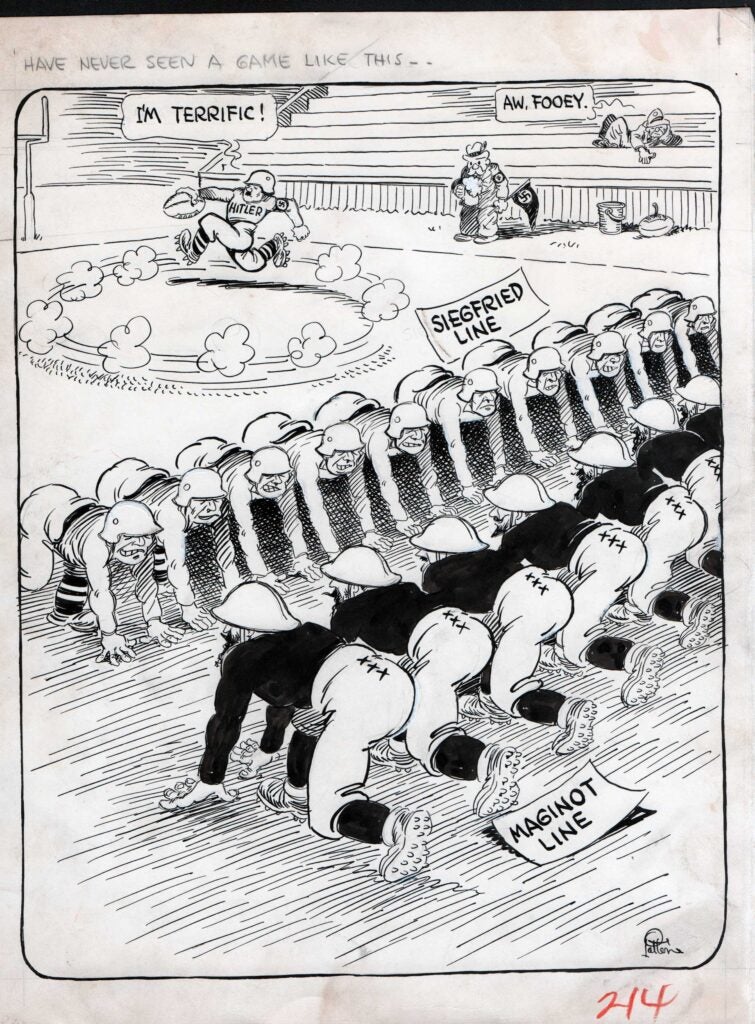1939.10.13 “I Have Never Seen a Game Like This” (October 13, 1939)
sby Jack Patton (1900-1962)
12 x 14 in., ink and crayon on board
Coppola Collection

Jack Patton was originally from Louisiana. He worked as an editorial cartoonist from the 1910s through the 1930s. In the 1930s, he was a widely read editorial cartoonist for The Dallas Morning News. His last editorial cartoons appeared at the end 1939 and perhaps through the start of 1940. During the 1930s, he also began the newspaper strip ‘Restless Age,’ which was followed by ‘Spence Easley’.
As a child, Patton read a magazine advertisement offering easy lessons in drawing. He signed up for a brief course, and it was enough to whet his appetite for a lifetime of cartooning. Scraping together enough money to get to Chicago, he enrolled in the Academy of Fine Arts. While at the school, he received word that the old Dallas Journal, then the evening publication of The Dallas News, needed an assistant in the art department. Hurrying back to his hometown, Mr. Patton found to his delight that he would work with veteran News cartoonist John Knott. The year was 1918 and two years later his editorial cartoons won a place on page 1 of the Journal. In the early part of his career, Mr. Patton was one of the first men in the business to put out both an editorial cartoon and a comic strip daily. The editorial cartoons had a stinging wit, and the originals were frequently requested by the subjects, including Franklin D. Roosevelt, Herbert Hoover and John Nance Garner.
The Maginot Line is a strong of concrete fortifications, obstacles and weapon installations built by France in the 1930s to deter invasion by Germany and force them to move around the fortifications. The Maginot Line was impervious to most forms of attack. In consequence, the Germans invaded through the Low Countries in 1940, passing it to the north. The line, which was supposed to be fully extended further towards the west to avoid such an occurrence, was finally scaled back in response to demands from Belgium. Indeed, Belgium feared it would be sacrificed in the event of another German invasion. The line has since become a metaphor for expensive efforts that offer a false sense of security.
The Siegfried Line, known in German as the Westwall, was a German defensive line built during the 1930s opposite the French Maginot Line. The Siegfried Line was a World War II German defensive system stretching some 390 miles along the western border of the old German Empire and referred to as the Westwall by the Germans.
Despite France’s declaration of war on Germany (September 3, 1939) after Germany had invaded Poland three days earlier, there was no major combat at the Siegfried Line except for a minor offensive by the French. Instead, both sides remained stuck in the so-called Phoney War (September 1939 through April 1940), where neither side attacked the other and both stayed in their safe positions.
The Saar Offensive was a French invasion of Saarland, Germany from September 7-16, 1939. When the swift victory in Poland allowed Germany to reinforce its lines with homecoming troops, the offensive was halted. The French opted to fight a defensive war, forcing the Germans to come to them. French General Maurice Gamelin ordered his troops to stop no closer than 1 km from the German positions along the Siegfried Line. At the same time, French divisions were ordered to withdraw to their barracks along the Maginot Line, beginning the Phoney War.
The World War II German invasion plan of France for May 1940, following its capture of Norway (ending the phoney war) was designed to deal with the line. A decoy force sat opposite the line while a second Army Group cut through the Low Countries of Belgium and the Netherlands, as well as through the Ardennes Forest, which lay north of the main French defenses. Thus the Germans were able to avoid a direct assault on the Maginot Line by violating the neutrality of Belgium, Luxembourg and the Netherlands. Attacking on May 10, German forces were well into France within five days and they continued to advance until May 24, when they stopped near Dunkirk.

